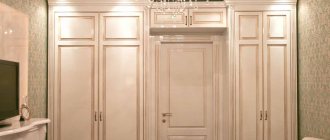It's time for renovation and the idea of demolishing the wall between the kitchen and the nearest room has matured? Or did you just decide to remove the kitchen door as unnecessary? Or maybe you are going to buy an apartment with illegal redevelopment? Agree, when such desires arise in a gasified apartment, they give rise to many doubts about legality and registration.
To protect yourself from the possibility of gas poisoning or fire, and from claims and fines from gas workers, study the requirements for the door to the kitchen with a gas stove or water heater, and other related regulations. In this article, we have collected all the important information on the topic, so you don’t need to rummage through a cloud of regulations, rules and other documents.
From this article you will learn about the current regulations that gas workers can refer to, as well as in which room you can install the stove without any problems. In addition, you will receive several options for resolving the issue with step-by-step instructions, advantages and disadvantages - everything in order to make and implement the right decision.
Doorway to the kitchen without a door to the corridor
When renovating small apartments with narrow corridors, they are increasingly abandoning the door to the kitchen. An open entrance allows you to visually increase the space and save space. In this case, a partition remains that performs zoning functions.
In large private houses, a beautifully decorated entrance to the kitchen from the hall or living room can be a whole work of art and interior decoration.
A wide span can be so functional.
After dismantling the door frame, the entrance from the corridor and other adjacent rooms, for example, the dining room or living room, can be decorated with various materials and different shapes. But you need to remember a few important points.
An open doorway is a better idea if there is a corridor between the kitchen and other rooms.
Entrance to the kitchen in Khrushchev
When entering the living room, you may need not only a powerful, but also a quieter hood so as not to disturb the guests’ rest.
Style mismatch
Despite the fact that the two rooms perform different functions, it is worth decorating them in the same style. We advise you to choose a direction in advance so that as a result you get a solid, complete design, and not a set of disparate pieces of furniture and decor. The decoration of the two zones should also have something in common with matching colors and similar lines.
- If functionality is a priority (easy cleaning, furniture in accordance with needs), choose a modern style.
- If you want to rely on decorativeness and noble materials, give preference to the classics.
- Country style is suitable for a country house or its imitation.
A kitchen-living room in a small apartment is sometimes the only way to create a free and ergonomic space. To turn a room into a functional space, it is important to consider many aspects and avoid annoying mistakes.
Examples of the most successful design options
When finishing an open doorway there are practically no restrictions on the choice of materials.
This could be a stone or brick design.
You can finish the span with the same materials as the walls.
You can use gypsum plaster to create a semblance of stucco.
Here are some solutions on how to design a doorway without a door to the kitchen.
Finished rectangular opening
The most versatile and simple option. After dismantling the door frame, the passage into the kitchen is left in the same shape.
Or they can be highlighted with plastic or wooden panels, covered with wallpaper or decorative plaster. The choice of materials depends on the style of the interior.
The entrance can be framed by narrow built-in display cabinets, as in the photo below.
Arch-shaped
The ceiling, recognizable by its graceful curve, is one of the most popular alternatives to interior doors.
The arch can be symmetrical or irregular in shape. Such unusual shapes can be achieved using plasterboard construction.
How to make an arch with your own hands, watch the video:
More ideas for decorating with different materials can be seen in the photo gallery below.
Photo gallery of ideas and design techniques (30 photos)
In classical styles, stucco molding or decorative wooden inserts and column platbands are suitable for decoration.
Modern design welcomes simplicity in forms and restraint in decorative elements.
The following materials can be used.
Depending on the style of the kitchen, there can be either rough wooden beams or elegant trim.
We have already given it as an example above. It allows you to create structures of irregular shapes, with shelves, racks, a bar counter, etc.
These can be curtains with tiebacks or thread curtains.
Source
Installation standards
The rules for installing gas stoves or built-in gas panels are described in detail in the instructions from the manufacturer. The technical characteristics of each type of burner are also given there.
Important! Installation of any gas-using equipment, including stoves, is carried out by a specialized organization that has a license for this type of work. If the device is connected by unqualified personnel, there is a risk of gas leakage and explosion. Independent installation and connection of gas-using equipment, which includes stoves, is considered a violation. The consumer is only allowed to perform actions that are performed without a tool.
The work is carried out according to the manufacturer's instructions, taking into account the existing technical connection conditions and the requirements of the local gas service in the following order:
- Make sure that the stove complies with GOST 33998-2016 and is equipped with a “gas control” system that stops the gas supply to the burner when the flame goes out.
- Before installation and connection, check that the type and pressure of gas in the local gas network are compatible with the settings of the device. If necessary, adjust to a different type of gas by replacing the nozzles.
- The device is placed in a strictly horizontal position using set screws and legs.
- Connect the equipment to gas using certified flexible hoses, which should not touch the heated back wall of the appliance and the top of the oven.
- A dielectric insert is placed between the gas tap and the hose, meeting the standards for interrupting the current and passing the full gas flow.
- Seals are used only once.
- After installation, check the tightness of the connections made with a soapy sponge. Apply soap foam to the connection points and see if air escapes.
- Light all burners, checking the stability of the flame at low and high temperatures.
How to widen a doorway
Before complete or partial demolition of load-bearing structures, it is imperative to consult with specialists. In an apartment building, you should start with the management company, in a private building - with the BTI. They will tell you whether this can be done at all, and whether additional reinforcement is required.
The most common solution is to partially or completely remove the partition between the living room and the kitchen, the kitchen and the dining room, the bedroom and the loggia, the kitchen and the balcony, the corridor and the dressing room, the hallway and the living room.
Advantages and disadvantages of the solution
Among the advantages are improved ventilation, as well as a functional increase in area - a utility room can be connected to the main room. These pros easily turn into cons. Too much ventilation causes drafts. The smell from the kitchen spreads throughout the house. Curtains perfectly absorb grease in the air, trap dust and require frequent washing.
The non-standard nature of the solution is an undoubted advantage, but it also has its downside. The interior of the apartment should be designed in the same style. It may not be easy to achieve this, but otherwise there will be disharmony.
Advantages of a living room-studio
Zoning
- It becomes possible to functionally zone the space and move the dining area from the kitchen to a more spacious place.
- The resulting spacious room can be given your favorite style and an individual design.
- The new room will receive greater illumination and a visual expansion of boundaries.
What can be done instead of a door to the kitchen: options for designing the opening
Most designers unanimously claim that a kitchen without a door is the most current solution, taking into account the widespread fashion for combining it with a living room, dining room or corridor. Among the arguments are more efficient use of space, visual increase in area, and proper zoning.
This solution also has disadvantages - and for some they can be decisive. Some people are frightened by the situation in which they will have to “enjoy” the smell of fish that a family member is cooking - and neither a strong hood nor wide open windows will save you from such an aroma. Someone is not ready to give up personal space, which is only in the kitchen.
The theme of designing a doorway without a door between the kitchen and the living room or corridor has never been more relevant. In this article we will try to highlight all the nuances and pitfalls.
Peculiarities
As you know, a kitchen is a room where food is constantly processed and dishes are prepared. Most of the time it is filled with vapors and food odors. All this makes the room damp and quickly dirty, which makes it much more difficult to maintain the doors, shortening their service life, and this is especially unpleasant if they are made from expensive types of wood.
But this is not the only problem - it is known that doors visually make already small rooms smaller. In addition, the need to open the doors reduces the space for arranging functional areas - the designers calculated that a standard swing model hides about 1 square meter. m area.
An open doorway, on the contrary, will visually expand the boundaries of the kitchen and ergonomically combine the kitchen with the living room or dining room.
The advantages of open openings also include aesthetics and a non-standard appearance - with proper and stylish decor, the passage can look very stylish.
The absence of a door leaf blocking the movement of air masses promotes normal air circulation and maintains a favorable microclimate in the room.
However, not everyone likes doorways without a door, since they do not allow the room to be completely isolated.
In fairness, it should be noted that when it comes to the kitchen, this is not critical, unless, of course, the door is needed to separate the room from the bedroom or children's room.
In what cases can and cannot be removed?
It makes no sense to solve this issue separately from the general concept and layout of the apartment. Before you get rid of doors in your kitchen, answer the following questions:
Without answers to these questions, we do not recommend removing the door between the kitchen and the adjacent room. And in some cases it is even prohibited by law.
If your kitchen has an area of 12 square meters or less, and it has a gas heater or stove, then according to fire safety regulations, the door is not allowed to be removed.
“But no one will check,” you say. Yes, but exactly until the moment you decide to sell the apartment. In this case, a violation will be detected, and this is fraught with a fine and restoration of the classic doorway.
Now let's discuss this solution in terms of comfort and functionality.
In what cases is door demolition recommended:
Disadvantages of this solution:
Premises requirements
Gone are the days when tiny Khrushchev-era kitchens quietly placed four-burner gas stoves by the window, next to hanging curtains.
Now the situation has changed. A new regulatory document has been approved and put into effect - SP 402.1325800.2018 “Residential buildings. Rules for the design of gas consumption systems." It includes a number of requirements for premises in which gas stoves are allowed to be installed:
- purpose of the premises - kitchens, kitchen-dining rooms, corridors;
- ceiling height - at least 2.2 m;
- the presence of natural ventilation, an exhaust ventilation duct and a window with an opening sash or window;
- the door from the room opens outward;
- there is a gap of at least 0.02 m² between the floor and the door leaf (for air flow);
- minimum room volume: for two-burner stoves - at least 8 m³, for three-burner stoves - at least 12 m³, for four-burner stoves - at least 15 m³;
- window glazing area - at the rate of at least 0.03 m² per 1 m³ of room volume (glass acts as an easily removable enclosing structure in the event of an explosion).
These requirements apply to both free-standing and built-in devices.
What can be done instead of a door?
Don't forget that the kitchen is a place of high humidity, temperature and dirt. Therefore, when choosing the finishing of a doorway, focus on the most wear-resistant materials - unless, of course, you enjoy redoing repairs every year.
There are two fundamentally different forms of opening:
In most cases, partial dismantling of the wall is done, because the size of the doors in typical high-rise buildings does not allow imagination to run wild. Typically, their height does not exceed 2 meters and their width is 70 cm.
Expanding the opening in a load-bearing wall is considered a redevelopment and must be approved by the relevant authorities. We wrote about how to coordinate the creation of an arch in a load-bearing wall here >>>
Let's consider various options that can be installed instead of a door in the kitchen - both popular and not so popular.
Portal
A portal instead of a door is the simplest and most versatile option for the kitchen that you can think of. After dismantling the door, the opening is left in the same shape, rectangular. It can be covered with wallpaper, MDF or plastic panels, covered with decorative plaster, etc.
In Khrushchev or other small-sized buildings, where you need to save every meter, the portal can be framed with cabinets, shelves, and display cases. Examples of such execution can be seen in the photo below:
An arch is the most popular option for decorating an entrance to a kitchen without doors. The frame is realized using a metal base, plasterboard, plywood or plastic, which allows you to create a structure of almost any shape. Subsequently, the arched opening is lined with any material.
Forms
The shape of the arch is:
Decor
We offer several interesting options for finishing the arch. Since it faces two rooms, consider how it will look from both sides.
Arches look very impressive, the lower part of which goes into the bar counter. Previously, it was used to prepare cocktails in the kitchen and immediately transfer it to the living room.
Decorative stone or brick
They use both natural (marble, granite, shell rock, quartzite) and artificial materials - the only difference is the price and complexity of the work. Please note that plasterboard partitions will not support heavy natural stone.
Methods for visually separating zones
Various floor coverings
The cooking area occupies a minimal area, while the main part of the room is in the living and dining areas. The use of different floor coverings allows you to visually delimit the space. Practical ceramic tiles that are not afraid of spilled water and mechanical damage are suitable for the kitchen. Laminate flooring is laid in the main part of the room. This material is available in a huge number of colors, does not require complex care, and is affordable. Carpet and classic parquet are also suitable for the living room. To make the separation more pronounced, contrasting colors are used.
A multi-level stretch ceiling with a combination of matte and glossy areas also allows you to delimit zones. By choosing colors, textures or photo printing on the canvas, you will play with the division of space in an interesting way.
Dinner table
Lighting plays an important role in the zoning process. Various lighting fixtures placed on the ceiling, walls or furniture highlight or conceal individual areas in the shadows. For the working corner in the kitchen, spotlights are installed; at the demarcation point, above the table or bar counter, pendant lamps with original lampshades look appropriate. A chandelier is suspended in the recreation area, and individual secluded areas are illuminated by sconces and a floor lamp.
How to separate the kitchen from the hallway without a door?
If the kitchen opens into a narrow corridor or hallway, then eliminating the door can be a good solution.
The advantages of this option:
Minuses:
If some disadvantages turn out to be critical for you, then consider dividing the kitchen and hallway with a sliding partition.
How can you play with the transition of the kitchen into a corridor without a door:
As you can see, there are many ways to refine the opening between the kitchen and the corridor, with the help of which these rooms can be combined or separated - it all depends on your preferences.
How much do the services cost?
A lot of money will be required in order for the redevelopment, the combination of the kitchen and room into a single room, as well as the project itself to comply with legal requirements.
The price may vary from company to company, but on average it has the following indicators:
| Service | Cost (in rub.) |
| Creating an individual project | from 9000 |
| Technical inspection | from 6000 |
| Certificate of completed redevelopment | from 15000 |
| Technical conclusion | from 5000 |
| Ordering BTI documents | from 5000 |
| Making changes to the BTI after redevelopment | from 7000 |
Built-in wardrobe dismantled
If the closet is on the floor plan of the house, and in the explication (apartment plan) it is highlighted as a separate room (the built-in closet has its own number and the area is indicated), then its installation and dismantling must be coordinated. This is a redevelopment.
To find out whether your closet is indicated on the plan, you need to request this plan from the BTI. The cost of such a service in Moscow is 5.8 rubles per square meter.
Demolition of such a cabinet without approval will lead to the redevelopment being considered illegal.
Installed an interior partition
If you installed a partition in the living room to zone the space (a corner with a sofa and TV and a bedroom), then you need to coordinate this. By law, the installation of partitions is considered redevelopment. Their installation or transfer requires mandatory approval. Moreover, this applies to houses with wooden and reinforced concrete floors.
But there is an exception here. The installation of a partition is considered a redevelopment only if it creates an excess load on the floors. The law stipulates the maximum thickness for partitions made of brick, as well as tongue-and-groove, expanded clay concrete, foam concrete and gas silicate blocks - no more than 10 cm. Partitions made of any other material should not create a load of more than 150 kg per square meter.
If the partition does not touch the capital ceilings at all or touches but does not increase the load on them, then its construction can be classified as repair or reconstruction work. In this case, installation permission is not required. But it is better to first consult with the relevant local administration authorities, study the Housing Code and Construction Norms and Regulations on your own, or contact private specialists. The services of the latter can cost from 1 thousand rubles (average cost in Moscow). However, some companies are willing to provide consultations for free.











